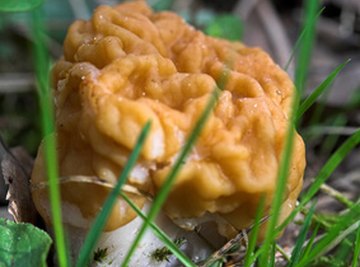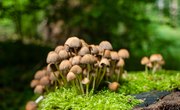
You see them pop up in your yard after rain or growing on trees like giant sponges--mushrooms appear everywhere. With spring bringing these beauties out in abundance, identifying edible mushrooms from poisonous ones can mean the difference between life and death. Prized for their flavor, morel mushrooms make a delicious find for mushroom hunters. However, their poisonous counterpart, the false morel, cab be easily mistaken for the edible.
Mushrooms
Mushrooms grow in many different types of habitats from your lawn to the woods. These mushrooms play an important role in nature--many encourage good tree growth and others work as decay organisms. Mushrooms also make a delectable meal, but make certain to thoroughly cook all mushrooms before consuming.
Morel Mushrooms
These highly sought after mushrooms offer a lucrative industry for mushroom pickers. Morel mushrooms (Morchella sp.) fruit from two to six weeks and price from $5 to $50 per pound. However, they begin to lose their moisture within 24 hours. Thus, morel mushrooms are often dried and then stored. These highly edible mushrooms have a poisonous counterpart, false morels, that can prove deadly on consumption if not properly identified before picking.
False Morel Mushrooms
Mushrooms in the Gyromitra genus fall under the category of false morels, appearing through spring at the same time as morel mushrooms. Gyromitra species come in many shapes, sizes and colors, including solid stems, lobed, ruffled and brain-like patterns on the caps. Many gyromitras also have caps with a reddish hue. Some false morels resemble regular morels very closely.
Poisonous Effects
Unlike morel mushrooms, false morels are poisonous and eating them can cause illness or even death. False morels contain the toxin gytomitrin that, when ingested, produces monomethylhydrazine (MMH), the leading chemical in rocket fuel, according to the University of Alaska. In addition, false morels possess carcinogens, which carry long-term health risks.
Symptoms of False Morel
If you do accidently ingest a false morel mushroom, symptoms appear between two and 24 hours after eating the mushroom. Symptoms include headache, diarrhea, lack of muscle coordination and abdominal pain. If a severe reaction takes place, symptoms include high fever, convulsions, coma and death, according to the University of Alaska.
Distinguishing False Morels
When hunting for mushrooms, taking along a field identification guide helps ensure that the mushroom you just picked is indeed what you think it is. The best way to distinguish between morel mushrooms and false morel mushrooms, according to the Mushroom Expert, comes when you slice them open. Morel mushrooms have a hollow center, while false morels do not.
References
About the Author
A Kansas-based writer, Alecia Stuchlik has been writing since 2007. Her articles have appeared in “K-State’s Statements” and “Manhattan Magazine.” She has a Bachelor of Arts from Kansas State University in anthropology and English.
Photo Credits
first mushrooms. image by firsov from Fotolia.com
